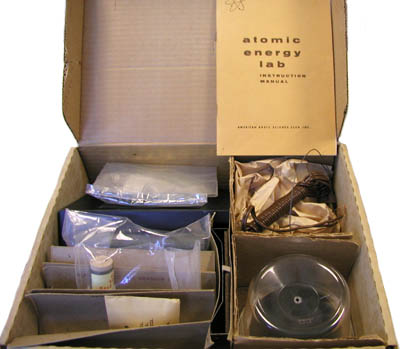Atomic Energy Lab (ca. 1960s)

This Atomic Energy Lab was one of a series of similar science kits (eight in 1957 and ten in 1973) that were produced by the American Basic Science Club. These kits could be obtained separately, but buyers were encouraged to purchase all of them in a one kit-a-month “club.” Purchased separately, the Atomic Energy lab (at various times, Kit No. 6 and 8) went for $5.95 (in 1962).
The American Basic Science Club, “a science course with the future in mind,” was the creation of James (Jimmy) Kerr who had previously owned an appliance store in Austin, Texas. It, the Science Club, operated from 1957 until the early 1980s.
It featured a spinthariscope, a cloud chamber, an electroscope, an alpha source (radium) and uranium ore. The instruction booklet had a copyright date of 1959.
All of the equipment has to be assembled, none of it is ready to go right out of the box. That's what I like about this kit: it doesn't present the experiments on a silver platter, they are mini construction projects.

The spinthariscope is assembled by coupling an optical lens to an alpha source. The latter consists of a pin stuck into a cork—the surface of the cork is coated with zinc sulfide (ZnS) and the exposed tip of the pin has radium on it. When the zinc sulfide is viewed through the lens in the dark, tiny flashes of light can be seen as the alpha particles from the radium strike the ZnS crystals.
The cloud chamber is fashioned from a clear plastic container (lower right corner of photo). The bottom of the chamber is formed from a disk of black paper that is kept cold with a block of dry ice. The pin with the radium on it is introduced into the cloud chamber through a small hole in the top of the plastic container. A few drops of alcohol are added to produce the vapor. A light bulb inside a metal box with a condensing lens on the side serves as the source of illumination.
The electroscope is fashioned from the same metal box used to construct the light source for the cloud chamber. Aluminum foil is used to make the electroscope leaf, and the leaf is viewed with the same lens employed in the spinthariscope.
